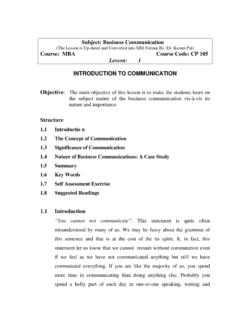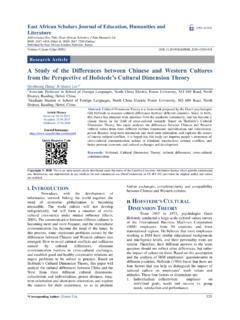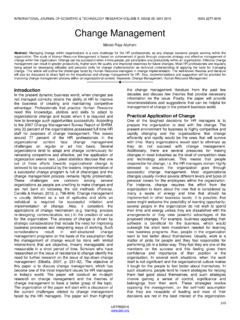Transcription of Internal Communication Toolkit - Civicus
1 Internal Communication Toolkit Internal Communication Toolkit by Jessica Hume (Please email feedback to 1 Overview Welcome to this Toolkit on developing an Internal Communication strategy for your organisation. The aim of the Toolkit is to help organisations to improve their efficiency and effectiveness through the creation of Internal Communication processes that create a cohesive organisational culture. Civil society organisations are focused on specific issues, on improving situations and having a real impact in addressing the many challenges facing the world. Often, the focus is so exclusively on what is going on out there that very little attention is given to what is going on within the organisation. Communicating and sharing information with colleagues is overlooked as everyone concentrates on getting work done and achieving the organisation s objectives. Within Communication strategies, Internal Communication is often overlooked, yet it is vitally important.)
2 It is the Communication that relates directly to the foundation of your organisation: the people staff, management and volunteers that give your organisation its ability to function. Developing sound Internal Communication processes and evaluating these processes on a regular basis is the same as making sure your car runs smoothly and is serviced regularly. If the many different pieces of your car do not fit smoothly together, you will not get where you are going very quickly, if you get there at all. Similarly, if the people that make up your organisation do not work together effectively, your organisation will not achieve its objectives as fast, if at all. An Internal Communication strategy is the key to ensuring a cohesive organisation focused on achieving its goals and objectives. Your Internal Communication strategy should emerge from, and be guided by, your organisation s overall strategic plan. This is because strategic Internal Communication is simply a step towards helping your organisation achieve its aims more effectively.
3 Improving your Internal Communication requires careful thought, creativity and detailed planning. As well, monitoring and evaluation must be built into your plan. As your Internal Communication plan should be integrated within your organisation s overall structure and strategic plan, you may find these other Civicus toolkits (available at ) useful in starting the planning process: Strategic planning Monitoring and evaluation Action planning Overview of planning Budgeting Civicus also offers two toolkits to assist your Internal written Communication : Writing effectively and powerfully, and Writings within your organisation . In addition, the following three toolkits will help you plan your external Communication , which should be done in conjunction with your Internal Communication plan: Promoting your organisation Handling the media Producing your own media We refer to these toolkits and sections within them throughout this Toolkit . Note: this Toolkit focuses primarily on staff-management Communication and not inter-management, staff/management-board or inter-board Communication .
4 In addition several important and in many cases sensitive issues such as change management, social exclusion, harassment and multi-cultural Communication are not discussed in detail. This Toolkit should be taken only as an introduction to Internal Communication and not a complete guide to all the issues that arise in this area. Internal Communication Toolkit Internal Communication Toolkit by Jessica Hume (Please email feedback to 2 Site Map Internal Communication Toolkit - Getting to know the organisation - Developing the strategy - Next steps - Determine your goal - Define your objectives - Identify your key messages - Define your audience - Identify tools and tactics - Develop an implementation plan - Finalise your strategy - In person - Notices and publications - Information and Communication technologies - Limitations of tools and tactics Overview References and Resources (At the end of the Toolkit ) The Process Tools and Tactics Case Study Introduction Monitoring and evaluation - What is Internal Communication ?)
5 - How significant is Internal Communication ? - What are some of the benefits of effective Internal Communication ? - What are the main principles of effect Internal Communication ? Developing a strategy Taking a close look at your organisation - What are your mission, goals, and values? - What is your organisation s structure? - Who makes up your organisation? - What characterises your organisation s culture? - What Communication tools does your organisation have? - What are your Internal Communication needs? - How do you answer these questions? Appendix A: Sample Internal Communication Survey Appendix B: Sample Internal Communication Strategy Internal Communication Toolkit Internal Communication Toolkit by Jessica Hume (Please email feedback to 3 Who will find this Toolkit useful? This Toolkit will be useful for all organisations that want to improve their Internal Communication . In particular, it will be useful for those organisations that want to improve the efficiency and effectiveness of their organisation by creating increased cohesion among staff, management and volunteers.)
6 In addition, the Toolkit also offers food for thought and some tips for organisations that may already feel that they have effective Internal Communication process but want to ensure that these are maintained and utilised consistently. A brief description of the Toolkit This Toolkit offers you an opportunity to think hard about whether your organisation needs to improve its Internal Communication . If you decide you need to, it offers practical guidance on how to do it. On this site you will find: Introduction Here we look at what Internal Communication is, why it is important and the benefits of having effective Internal Communication . In addition, we discover some of the key principles of successful Internal Communication . The strategic Internal Communication process Here we look at the three steps in the strategic Internal Communication process: taking a close look at your organisation, developing and implementing a strategy and monitoring and evaluation. We discuss the questions you need to ask of your organisation before you develop an Internal Communication plan and how to go about finding the answers.
7 Then we go step-by-step through the process of developing an Internal Communication plan and implementing it. Finally, we discuss the need for monitoring and evaluation the process in order to ensure that it achieves the desired goals and adapts to meet changing circumstances and needs. Tools and Tactics Here we discuss the different tools and tactics that you can use to improve Internal Communication . Tactics can use tools that require face to face meetings, written notices and publication or information and Communication technologies. We discuss the benefits of each type and elaborate on some of the different tactics that can be used. Finally, we highlight some of the limitations of tools and tactics in general Case Study: Building a cohesive organisation Based on a real experience, this case study looks at how one organisation undertook the strategic Internal Communication process. Particular attention is paid to how the organisation adapted the process to meet its own circumstances and needs.
8 Internal Communication Toolkit Internal Communication Toolkit by Jessica Hume (Please email feedback to 4 Introduction What is Internal Communication ? Internal Communication does not refer only to those few official channels of Communication within your organisation, such as Internal newsletters, notice boards or staff meetings. It is not a process that goes from the top, the Chief, to the bottom, the intern. Rather, Internal Communication refers to the almost constant interactions within your organisation that convey meaning. Therefore, Internal Communication encompasses both overt Communication like meetings, memos etc, and more casual forms of Communication such as gossip, pleasantries and body language. How significant is Internal Communication ? Internal Communication is significant in any organisation because it is the building block of the organisational culture. The organisational culture is the atmosphere of the organisation based on its values, mission and work processes.)
9 When every member of the organisation holds the same values, understands the work policies and procedures in the same way, and is focused on the same mission, the organisational culture promotes much more effective use of resources then under a culture that is more diffuse in its interpretation. Within the non-governmental community, Internal Communication and its effects on organisational culture is just as important as in the corporate sector, perhaps even more so. Just because your organisation has what you believe to be a clear mission, based on basic values of human dignity and human rights, does not mean that all members of your organisation interpret that mission and those values in the same manner. Example: An adult literacy organisation has a mission to assist disadvantaged adults obtain their high school diplomas. The executive director of the organisation assumes that to be illiterate is to be disadvantaged, and therefore sees the organisation as assisting all illiterate adults.
10 Meanwhile, a project manager interprets disadvantaged as having something in addition to being illiterate, such as a learning disability and/or substance abuse problem. Therefore, in designing and implementing a project, the manager carefully targets a select group of people who have these problems. The executive director is then left wondering why the organisation is not achieving the goals she or he has set for it. Within this hypothetical organisation, there is no communally held interpretation of the organisation s mission. The executive director and the project manager may not necessarily be working at cross-purposes, but they are not working as effectively together as they could be. Effective Internal Communication can ensure that all members of an organisation are working towards a common goal and assisting each other effectively. What are some of the benefits of effective Internal Communication ? When your organisation is communicating effectively with its Internal stakeholders, whether they are employees, management or volunteers, it develops a cohesive culture where everyone is focused on the same goals and has the same objectives.












